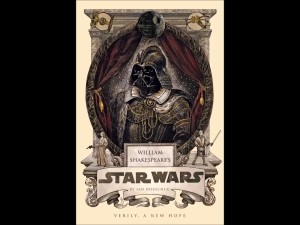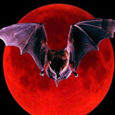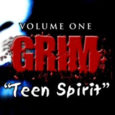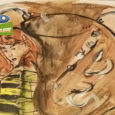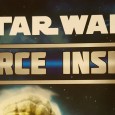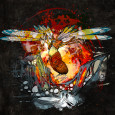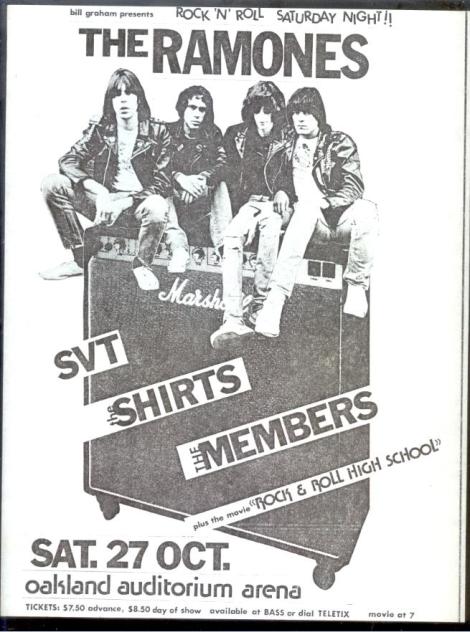The Star Wars Shakespeare books have finally wrapped up their six part series, and they are each more beautiful than the last.
In honor of this momentous occasion, Quirk Books is generously giving away one copy of the first in the series, Verily, A New Hope. We promise once you read the first you won’t be able to put the rest down.
In order to win this contest, which is truly “A thing divine, for nothing natural / I ever saw so noble.”*
**But we aren’t pigeon-liver’d, and we’re running this contest through Twitter!
All you have to do to enter is come up with a Shakespearean adaptation based on another movie. Tweet us a one-liner from your adaptation (For example, something like, “T-rex or not t-rex… that is the question.” – Jurassic World. And no you cant use that we dont know your life.) We’ll trust that you have the rest of the manuscript buried somewhere in your quarters near the Globe. Don’t worry, official rules are listed below.
At the end of the week, a team of our best Shakespearean experts (read: those of us who know more than just Romeo and Juliet) will sit down and heretofor judge the contest, which runs from Thursday, July 30th to Thursday, August 6th at 11:59 pm, PCT.
Alright so. To clarify: if you want to win a copy of Verily, A New Hope, here’s what you gotta do:
- follow Sub-Cultured on Twitter: @sub_cultured
- Tweet at us! We want to hear your best one-liner adapted FROM a movie INTO Shakespearean style writing.
- Make sure you get in your tweet between July 30th and August 6th. The contest ENDS at 11:59, 8/6/15 (Pacific Coastal time for all you west coasters)
Jen Schiller
Staff Writer
@jenisaur
*The Tempest
**Hamlet, not The Lion King. probably.
Be honest here. How many times did you just watch that video? Was that enough Star Wars told in the style of Shakespeare for you? No? Then I have some good news.
Verily, A New Hope, written by the brilliant Ian Doescher, turns Episode IV into an Elizabethan comedy set in deep space. The entire story is told in classic (and semi-difficult to master) iambic pentameter. As a theatre nerd, my very first reaction to this book was “holy crap we have to perform this”, and as I continued reading that instinct just got stronger and stronger. In fact, this book might well be the answer to “how do we get high schoolers interested in Shakespeare?” Doescher has created a text here that satisfies Star Wars and Shakespeare fans equally– in fact it even satisfied the Bearded One himself to the point where Verily is an officially licensed retelling of the original tale.
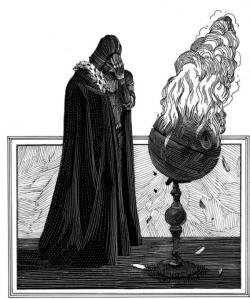 There are few things I love more than innovative storytelling, and Verily is nothing if not innovative. Although it barely takes a few stanzas before you’re thinking that Star Wars and Shakespeare are as classic a combination as peanut butter and jelly. (hey, I can use cliches. I’m not the bard.)
There are few things I love more than innovative storytelling, and Verily is nothing if not innovative. Although it barely takes a few stanzas before you’re thinking that Star Wars and Shakespeare are as classic a combination as peanut butter and jelly. (hey, I can use cliches. I’m not the bard.)
Doescher has created something that is at once familiar and unique. It is both faithful to the original text, and firmly in the world of adaptation. It blends old with new in a way that retains lines such as “that is no moon”, but also makes room for a loquacious R2. For instance:
“C-3P0: But Sir, no proverb warns the galaxy
Of how a droid may hotly anger’d be.
HAN: Aye, marry, ’tis because no droid hath e’er
Torn out of joint another being’s arms
Upon a lesser insult e’en than this–
But Wookies, golden droid, are not so tame.
C-3P0: Thy meaning, Sir, doth prick my circuit board.
‘Tis best to play the fool, and not the sage,
To say it brief: pray let the Wookie win.
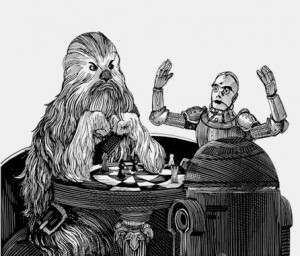
CHEWBAC.: Auugh!
R2-D2 [aside]: –Brute! The fool I’ll play with
thee indeed.
Yet I percieve thou and they friend have heart.”
Doescher includes an Afterword at the end of his book, explaining his inspiration and the timeline of influence that is drawn directly from Shakespeare to Lucas. In between the two giants of their art forms is Joseph Campbell and his classic text on literature, The Hero with a Thousand Faces. Lucas studied the text, which in turn studied Shakespeare’s work and the classic characteristics found therein. It would seem that Doescher’s exercise is a natural progression in literature. In other words, none of us should be surprised that Verily exists, or that it was created so successfully.
Two thumbs up, five out of five stars, and 10/10 points. Pick up your copy of Verily, A New Hope today from Quirk Books, or your local bookstore!
Jen Schiller
Staff Writer
twitter.com/Jenisaur
This week I am reviewing Quirk Books’ The Resurrectionist in preparation for this weekend’s Book Expo America. The aesthetics of the book are breathtaking and really bring the book alive, I mean really as soon as I finish this review I’m sending the book to a friend of mine who LOVES Gothic art.
 The Resurrectionist is broken into two basic parts, the first being a fictional biography of Dr. Spencer Black–a young biologist who becomes obsessed with proving that human mutations are examples of the body trying to revert to earlier forms of homo-sapiens. The second is a fictional collection of samples of Dr. Black’s work. This second half or “Codex Extinct Animalia” is filled with exquisite sketches of the taxidermy creatures that Dr. Black was supposed to have built out of exhumed bodies and dead animal parts. The sketches are more than mere curiosities, however–they are exact in every detail and strip the taxidermy creatures down to muscles and bones.
The Resurrectionist is broken into two basic parts, the first being a fictional biography of Dr. Spencer Black–a young biologist who becomes obsessed with proving that human mutations are examples of the body trying to revert to earlier forms of homo-sapiens. The second is a fictional collection of samples of Dr. Black’s work. This second half or “Codex Extinct Animalia” is filled with exquisite sketches of the taxidermy creatures that Dr. Black was supposed to have built out of exhumed bodies and dead animal parts. The sketches are more than mere curiosities, however–they are exact in every detail and strip the taxidermy creatures down to muscles and bones.
The split function of the book is an example of the article that I wrote over a year ago about the publishing world morphing to make books more valuable as physical artifacts. While the first portion of The Resurrectionist could function well as an eBook*, it is the second half that makes this book truly unique as a physical book on the bookshelf.
*The Resurrectionist has been released as an eBook for the kindle, and comes with a disclaimer that the file may take longer to load than most as it contains many oversized images, and has been “optimized for larger screens”
The illustrations in the Codex have all the attention to detail a biologist needs for his studies, and all the whimsy that a fantasy artist’s work needs to be believable. There are eleven creatures included in the book, pulled from fantasy and mythology from all over the world and throughout history. Each creatures gets several pages of description and “sketches” of how it would have existed, according to Dr. Black, had we not evolved into our current human state of boringness. 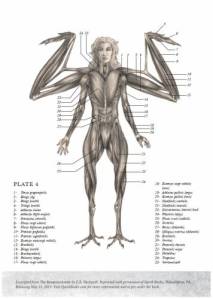 The Codex is apparently built from the late Doctor’s field notes and random lab sketches, and has been assembled posthumously on his behalf as he went insane and then disappeared from the public eye. If the biography itself hadn’t done a thorough enough job convincing you that a man like Dr. Black could have and may have existed, then these sketches and explanations will surely convince you that the fantastic creatures he investigated may have at one time roamed the Earth. What’s truly remarkable about this book is that it brings the fantastic into the real world while still keeping the two apart, like the separation of biography from field guide within the book itself.
The Codex is apparently built from the late Doctor’s field notes and random lab sketches, and has been assembled posthumously on his behalf as he went insane and then disappeared from the public eye. If the biography itself hadn’t done a thorough enough job convincing you that a man like Dr. Black could have and may have existed, then these sketches and explanations will surely convince you that the fantastic creatures he investigated may have at one time roamed the Earth. What’s truly remarkable about this book is that it brings the fantastic into the real world while still keeping the two apart, like the separation of biography from field guide within the book itself.
The Ressurectionist may not have been quite as successful if the two halves were separated, as neither is particularly unique. However, when artfully sewn together like one of Dr. Black’s “discoveries”, the whole that is created is something to be marveled.
order your copy of The Resurrectionist from Quirkbooks today!
Jen Schiller
Staff Writer
twitter.com/Jenisaur
You know how sometimes, you meet someone and you’re like “wow I didn’t know there was a gaping hole in my life where you were supposed to be…until you came along and filled it”?
That sounds gross. Let me start again.
You know how sometimes you see a GIF on tumblr at two in the morning and it’s like “wow I didn’t know I’d been waiting my whole life to a moving picture of Zac Efron dancing on a golf course”?
Hold on…that one sounds sad. One more time.
You know how sometimes, you find an amazing book that you never would have imagined existed in a million years, but once you find it, you realize it’s exactly what you’ve been looking for? Swissted is exactly that kind of book for me. (There we go. I guess sometimes the direct approach is the best one…)
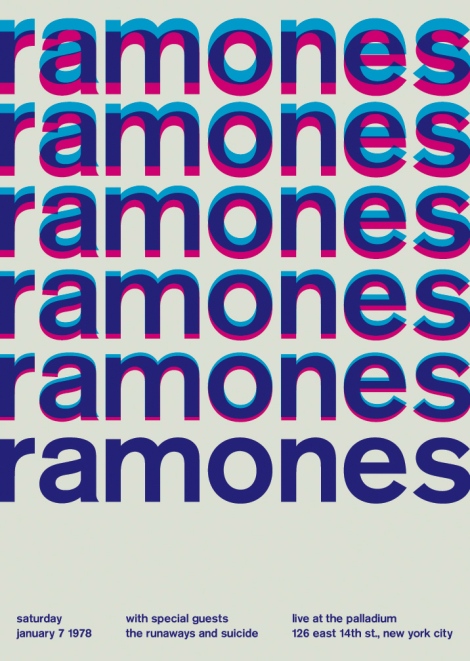 This book came across my desk about a month ago and I’ve been dragging my feet waiting to review it. Not really dragging my feet as totally absorbed in preparing for and then attending ICFA, but you know–tomato tomAto and all that. This book is another Poster sized monster from Quirk, much like the Presidential Election poster I reviewed last year. Swissted, however, does not aim to educate but rather to entertain and aesthetically please. On both counts, the book succeeds.
This book came across my desk about a month ago and I’ve been dragging my feet waiting to review it. Not really dragging my feet as totally absorbed in preparing for and then attending ICFA, but you know–tomato tomAto and all that. This book is another Poster sized monster from Quirk, much like the Presidential Election poster I reviewed last year. Swissted, however, does not aim to educate but rather to entertain and aesthetically please. On both counts, the book succeeds.
The concept behind Swissted is simple, on many levels. It redesigns classic punk concert posters using the simplistic aesthetic of Swiss Modernism.
If there is any educational value at all, it is in bringing the concepts of Swiss Modernism to a wide audience. The foreward, written by design critic Stephen Heller and the introduction, by author/designer Mike Joyce, help inform readers of the inspiration behind the designs. Perhaps Heller puts it best when he says “Swiss and punk are like champagne and whiskey: combined, they deliver a profound kick by leave you with quite a headache. That is, until Mike Joyce started mashing up the two ingredients into his own special cocktail”. The cocktail resulted in over 200 original works of art, perfect for ripping out and framing in your “modern, grown-up but not too grown up, art-appreciating but still still stickin’ it to the man” living space.
The “champagne and whiskey” combination works because it’s so different. Joyce describes both the world in which the grungy, photocopied posters of the original gigs were created, and then travels through time and his art education, where he became transfixed with the c0ncepts of the International Typographic Style movement. He draws a connection between the punk rock that started in the late 70s and this minimalist style: “The Swiss modernists purged extraneous decoration to create crystal-clear communication, while punk rock took on bloated self-indulgent rock and roll and stripped it to its core. Both created something new, powerful, timeless.”
Back to my original point: Joyce has struck on something here that readers may not have known they wanted until they saw it. Certainly that’s what he discovered with swissted.com, a small venue for this idea in its early stages that has since seen some major traffic (and led to the book deal with Quirk); the transformation of low-budget concert posters into clean, digital representations is perhaps something we’ve been waiting for all along.
For more information on Swissted or Mike Joyce, check out QuirkBooks.com/swissted. For more posters that didn’t make the cut, check swissted.com
Jen Schiller
Staff Writer
twitter.com/jenisaur
The Last Policeman is a sci-fi murder mystery set just shy of global apocalypse–but if you’re still not sold on it, you should know it’s unlike anything you’ve ever read. It is the first in a trilogy of books, each of which will follow the prematurely-hardened Detective Hank Palace, as he continues to do his work on the Police Force regardless of the Earth’s impending doom. The aforementioned doom is set to begin at the hands of a giant comet on a crash course with our planet, and scientists have pin-pointed its arrival time, but not where it will make contact. As a result, the population has changed, for better or worse: most people have quit their jobs in search of their “bucket list” life, and suicide rates are through the roof. Anarchy is the rule of the day when there are only six months left to live, but not for Palace, who never stops sleuthing even when the cards are firmly stacked against him.
Please enter the url to a YouTube video.The Video Trailer for The Last Policeman
I say that The Last Policeman is unlike any other apocalypse type book you’ve probably read simply because it is. For one thing, we often pre-occupy ourselves with POST-apocalyptic tales, where the Event is some unpredictable, world-altering thing that everyone learns from or laments that we couldn’t have seen coming. In Policeman, we do see it coming, and we don’t have any way to stop it. In an interview with Winters, conducted by Quirk, which published the book, Winters talked about some of the more interesting aspects he had to consider when creating Detective Palace’s world—namely the element of economic change, and psychological shifts in the human race at large. His research into how our economy would change, and the variety of ways in which people were most likely to react to such an Event, definitely paid off in that these elements rang almost spookily true in Policeman. They also force readers to place themselves into the position of the characters in the book: If you knew you only had six months to live, how would YOU spend it.
Further, the psychology behind impending apocalypse allowed Palace’s story to develop organically. The people around him were constantly questioning his motives so that the reader had no need to. As he continued to dig deeper into his case, chasing what seemed to be a series of dead-ends that all pointed to his own insanity, the simultaneously strange and familiar world around him came into sharper and sharper focus. Do kids still keep going to school? Do adults continue on working? Does the government still function? Who runs the television stations? What news could there possibly be besides “We’re all gonna die”?
Interesting too were the interpersonal relationships that developed or failed to develop in the face of a ticking clock barreling its way through space. Palace reminisces on his first girlfriend, and develops feelings for a new woman, at once point thinking to himself “This is it. This is the last time I’m going to fall in love.” The romance never overwhelms the mystery or sci-fi storylines, and in fact winds up as organic elements of the main plot to the novel—something that I was pleasantly surprised by in the end. Palace also grapples with his familial relationships—specifically with his absent parents and his obnoxiously non-absent younger sister. The circumstances of his parents’ absence become a surprising twist near the end of the novel, as we realize they may have had more to do with his strong work ethic than even he is willing to let on.
The Last Policeman is definitely not the type of book I’d typically read—I like to say that I read fantasy and watch science fiction, but Policeman was so enjoyable that I’m waiting less than patiently to see what Winters has up his sleeve for Palace in the next two books. He has already announced that each book will follow another case upon which Palace places himself, but with the events that take place at the end of Policeman, which I will NOT disclose here, I will be surprised to see how he ends up on another case ever again.
I highly recommend The Last Policeman to anyone looking for a masterfully crafted murder-mystery/sci-fi apocalypse story, with details in all the right places and dynamic characters who keep you turning page after page. And if you don’t know you’re looking for that yet, you’ll find out that you were when you take my advice—read The Last Policeman.
Read more about The Last Policeman on its official page at Quirk Books.
Image and video source: Quirkbooks.com

King Jackson
Happy week after Memorial Day! That’s a thing, right? I’m making it a thing, and celebrating by telling you about Quirk Books’ new title Presidential Campaign Posters: Two Hundred Years of Election Art. I thought this book was a joke when I first saw it, considering the cover prominently displays an image of Gerald Ford dressed like the Fonz; however it is all too real and the surprises don’t begin or end with Ford.
It’s not just the subject matter that makes this book unique, but also the format. As opposed to the typically stout mass-market paperbacks that make up most of the history section at any bookstore, Presidential Campaign Posters is tall and 208 pages long. It begins with Andrew Jackson pictured as a King by his opponents and ends with Obama’s “Hope” campaign. Each of the posters is perforated so it can easily be removed and framed, however the back includes factual and anecdotal information about the presidential race in which the poster featured. Even if I had the wall space, I prefer to preserve the book the way it is. Not only is each poster a gorgeous, high-quality re-print direct from the Library of Congress, but the story that the posters tell from beginning to end reveals how little has changed in our country’s politics in the last two centuries.
Really, when I first read about this book I thought it was a clever trick; some kind of satirical commentary on each president’s reign. I thought there was no way posters as ridiculous as President Carter dressed like Jesus could be real until I was flipping through this book and reading the stories that went along with each image.

Another very real Gem from our history
What fascinates me even more than the posters themselves is the narrative that they spell out about our history. Presidential elects have always tried to appeal to the common man, and no smear has ever been too low.
This book is credited to “Library of Congress” as the author. I’m a dramaturg, so I love research and love seeing it organized in interesting and innovative ways. My press copy of Presidential Campaign Posters arrived along with an interview with the Library of Congress’ Publishing Director W. Ralph Eubanks, and I wish that the interview had been included in the book itself. Eubanks specifically talks about how television changed the way that campaign posters were composed, and while the book touches on this element of campaign races it only does so briefly. Eubanks explains the broad effects: “Whereas early campaign posters were vehicles for publicizing candidates’ political messages, the post-1960 posters were simply ways to get the names of the candidates in the minds of the voters, with political messages communicated via television commercials and the news media.”
If I had a rating system of five stars, this book would get all five. It took a subject in which I was only mildly interested, and made me pour over pages and pages without realizing how much time had passed. Not only that, it’s a brilliant piece of dramaturgy and a fascinating way to present what could very well have been dry, dusty material. Highly recommended for…pretty much anyone who can read.


